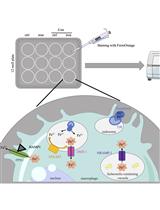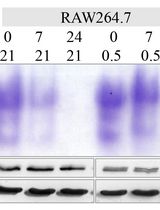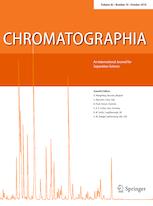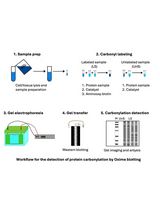- EN - English
- CN - 中文
Gas Chromatography Detection Protocol of Short-chain Fatty Acids in Mice Feces
小鼠粪便中短链脂肪酸的气相色谱检测
发布: 2020年07月05日第10卷第13期 DOI: 10.21769/BioProtoc.3672 浏览次数: 6821
评审: Alba BlesaSimab KanwalAnonymous reviewer(s)

相关实验方案

在平板检测仪中使用高特异性荧光探针定量巨噬细胞细胞二价铁 (Fe2+) 含量
Philipp Grubwieser [...] Christa Pfeifhofer-Obermair
2024年02月05日 2155 阅读

哺乳动物线粒体和胞质顺乌头酸酶的凝胶内活性测定——分区特异性氧化应激与铁状态的替代标志物
Wing-Hang Tong and Tracey A. Rouault
2024年12月05日 2114 阅读
Abstract
Short-chain fatty acids (SCFAs), which are formed mainly by bacteria fermenting undigested carbohydrates in the colon, they are based on the number of carbon atoms in the carbon chain. Organic fatty acids with less than 6 carbon atoms are called short-chain fatty acids. SCFAs are closely related to various aspects of the human body, so more and more researchers concentrate on SCFAs. This protocol describes, a direct injection gas chromatography detection method with a pretreatment method for extracting SCFA from mice feces by combining acidification. The corresponding sample limit of quantization (LOQ) and limit of detection (LOD) are 0.8-1.0 mg/L and 0.5-0.8 mg/L, respectively. The correlation coefficient of calibration curve is greater than 0.999. The recovery rate of the spiked standard is 80%-102%. This method can be used to analyze and determine SCFAs in mice feces. Therefore, this is an economical, effective and reproducible method for SCFAs measurement in mice samples.
Keywords: Short-chain fatty acids (短链脂肪酸)Background
Short-chain fatty acids (SCFAs) are important molecules that regulate and control biological functions (Siri-Tarino et al., 2015). SCFAs typically refer to volatile organic fatty acids with less than six carbon atoms (Wong et al., 2006; Marette and Jobin, 2015). They mainly include acetic acid, propionic acid, isobutyric acid, butyric acid, isovaleric acid, and valeric acid. SCFAs are mainly produced by the intestinal microbiota, which ferments undigested carbohydrates and dietary fiber in the colon. (Henningsson et al., 2001). Many studies have shown that branched fatty acids are derived from branched-chain amino acids and leucine (Koh et al., 2016). A small amount of branched-chain fatty acids are generated by fermenting undigested proteins (Cummings and Englyst, 1987), such as isobutyric acid and isovaleric acid. Numerous types of SCFAs are present in the colon, and have different functions, because bacteria are complex and fermentation substrates vary in the colon (Topping and Clifton, 2001). These metabolites are formed and absorbed in the colon and then transported through the hepatic vein to the liver. Only approximately 5% of SCFAs are excreted in feces and the remaining are absorbed by colon cells (Ruppin et al., 1980; Hu et al., 2010; Stumpff, 2018). SCFAs play an important role in maintaining the normal function of the large intestine and the morphology and function of colonic epithelial cells. Among other features, SCFAs contributes to the main role of the intestinal flora in the homeostasis of the host. Studies have shown that propionic acid, butyric acid and 3-hydroxybutyric acid, which are signaling molecules, play important roles in activating G protein-coupled receptors and inhibiting histone deacetylase activity (Johnstone, 2002; Xiong et al., 2004). The most abundant molecules in SCFAs are acetic acid, propionic acid, and butyric acid, which are usually present in deprotonated form. SCFAs are quickly absorbed by the hindgut and store energy. Acetic acid provides 10% of the body’s energy expenditure and is an important component of the collective energy source (Hu et al., 2010). The close relationship between SCFAs content in the human body and human health has always been the focus of research (O'Keefe, 2016). Therefore, a method for the rapid qualitative and quantitative analyses of SCFAs in complex biological matrices is needed to be developed (Fiorini et al., 2015).
Many detection techniques can be used for the qualitative and quantitative identification of SCFAs. Those include high-performance liquid chromatography (HPLC) (Torii et al., 2010; de Sá et al., 2011; Schiffels et al., 2011; De Baere et al., 2013), capillary electrophoresis (Saavedra et al., 2000), and ion exchange HILC (Horspool et al., 1991). However, these methods have several limitations in terms of poor sensitivity and low recovery (Saavedra et al., 2000; Destandau et al., 2005; Horspool et al., 1991). Gas chromatography (GC) is the most commonly used method for SCFA analysis because SCFAs are volatile. SCFA biological samples are prepared differently in terms of sample processing such as pretreatment, distillation, ultrafiltration, and extraction (Zhao et al., 2006; Fiorini et al., 2015; Hoving et al., 2018). However, the tedious and time-consuming pretreatment process may be one of the reasons for the decrease in detection sensitivity and recovery of SCFA.
Therefore, GC was chosen to detect SCFA, but a pretreatment method for processing biological samples needs to be developed. Such method must not only be simple and easy to implement, but also time-efficient. In this study, a simple and effective pretreatment method for the rapid qualitative and quantitative determination of SCFAs in mice feces via GC was developed. This approach can provide a basis for the analysis of SCFAs in other biological samples.
Materials and Reagents
- 100-1,000 µl pipette tip (Biosharp, catalog number: BS-1000-T)
- Micro-centrifuge tube, 5 ml (Biosharp, catalog number: BS-50-M)
- Disposable sterile syringe, 1 ml (Zhengzhou Kangjia Medical Equipment Co., Ltd)
- Clear short thread wide mouth sample bottle, 2 ml, vial with patch (32*11.6 mm) (Agilent Technologies, catalog number: 5182-0715)
- Blue screw cap (9 mm) (Agilent Technologies, catalog number: 5182-0717)
- Disposable sterile needle filter, Nylon 66, Aperture: 0.22 μm (Tianjin cypress Experimental Equipment Co., Ltd, catalog number: SFNF1322)
- Mice feces samples, stored at -20 °C after collection
- Hydrochloric acid, 37% (v/v) (Tianjin Fengchuan Chemical Reagent Technology Co., Ltd. CAS: 7647-01-0)
- Acetic acid, standard for GC, ≥ 99.8% (GC) (Aladdin Industrial Corporation, catalog number: A116165)
- Propionic acid, standard for GC, ≥ 99.5% (GC) (Aladdin Industrial Corporation, catalog number: P110443)
- Butyric acid, Standard for GC, > 99.5% (GC) (Aladdin Industrial Corporation, catalog number: B110439)
- Isobutyric acid, Standard for GC, ≥ 99.5% (GC) (Aladdin Industrial Corporation, catalog number: I103521)
- Valeric acid, Standard for GC, ≥ 99.5% (GC) (Aladdin Industrial Corporation, catalog number: V108269)
- Isovaleric acid, Standard for GC, ≥ 99.5% (GC) (Aladdin Industrial Corporation, catalog number: I108280)
- Ethyl acetate, Analytical purity, ≥ 99.5% (Tianjin Fuchen Chemical Reagent Co., Ltd.)
- 1 M HCl solution (see Recipes)
- SCFAs single standard solution (see Recipes)
- SCFAs mixed standard solution (see Recipes)
- Dilute SCFAs single standard solution with a dilution factor of 2, 4, 8, 10 times (see Recipes)
- SCFAs mixed standard solution (see Recipes)
- Dilute SCFAs mixed standard solution with 2, 4, 8, 10 Dilution Times (see Recipes)
Equipment
- 50 ml volumetric flask
- Beaker
- 100-1,000 µl pipette gun (Eppendorf, model: research plus)
- A gas chromatograph (Agilent 7890A, USA) equipped with flame ionization detector and an automatic sampler (Autosampler, model: 7683B)
- DB-FFAP capillary column with polyethylene glycol modified by terephthalic acid as stationary phase (30 m x 320 µm x 0.5 µm) (Agilent Technologies, USA, catalog number: 123-3233)
- Stainless steel spoon, 180 mm long, with the widest diameter of 3 mm
- Analytical balance (METTLER TOLEDO Instruments (Shanghai) Co., Ltd., model: ME204/02)
- Vortex mixer (Aoran Science and Technology Co., Ltd., model: SI-0246-G560E)
- Centrifuge (Changsha High-Tech Industrial Development Zone Xiangyi Centrifuge Instrument Co., Ltd., model: H1650R)
- Ultrasonic cleaner (Kunshan Hechuang Ultrasonic Instrument Co., Ltd., model: KH-500E)
Software
- Agilent ChemStation was used to analyze data (B.0403)
Procedure
文章信息
版权信息
© 2020 The Authors; exclusive licensee Bio-protocol LLC.
如何引用
Zhang, C., Liu, A., Zhang, T., Li, Y. and Zhao, H. (2020). Gas Chromatography Detection Protocol of Short-chain Fatty Acids in Mice Feces. Bio-protocol 10(13): e3672. DOI: 10.21769/BioProtoc.3672.
分类
生物化学 > 其它化合物 > 酸
细胞生物学 > 细胞新陈代谢 > 其它化合物
您对这篇实验方法有问题吗?
在此处发布您的问题,我们将邀请本文作者来回答。同时,我们会将您的问题发布到Bio-protocol Exchange,以便寻求社区成员的帮助。
Share
Bluesky
X
Copy link










